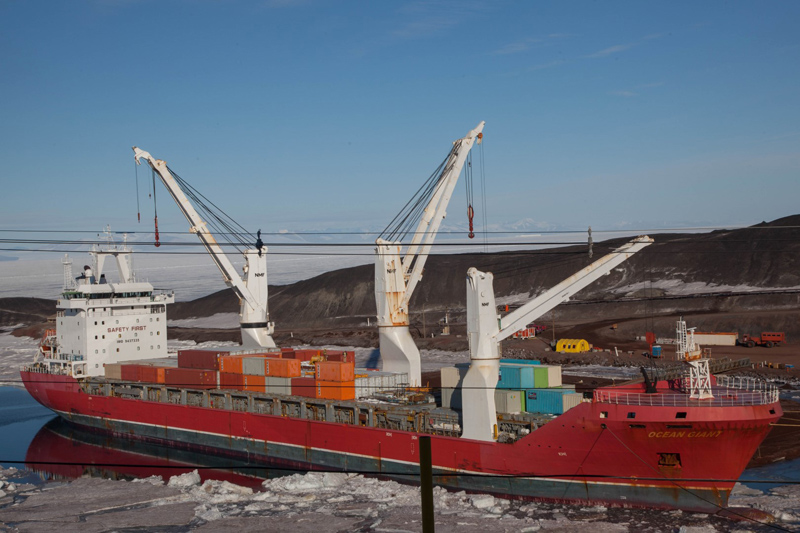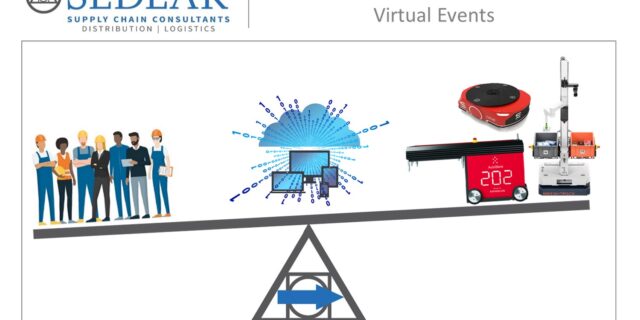The Supply Chain at the End of the Earth (2 of 3)
November 21, 2016 By: Senior Management | Topics: Facility & Operation Design, Inventory Planning & Optimization, Operations Improvement, Project Support & Management, Supply ChainThis three-part series explains Sedlak’s work in support of the Antarctic Infrastructure Modernization for Science (AIMS) project of the U.S. Antarctic Program (USAP) to redesign and reconstruct McMurdo Station on Ross Island, Antarctica. Sedlak’s focus is on optimizing the warehousing facilities and processes. Part 1 described the adventure of our team’s site visit to the continent and an overview of McMurdo Station. Part 2 explores in more detail the supply chain challenges in an extremely challenging environment.
Part 2 – The Challenges
When Sedlak consultant Shawn Sedlak walked off an LC-130 onto the ice runway at McMurdo Station, he was immediately taken in by his surroundings. “My first thoughts were a mix of how beautiful it was – seeing all the ice and the mountains in the distance – and how insane it was to be there,” he says.
His initial impression of the station itself, though, was less awe-inspiring.
“The first thing you see are these dilapidated buildings and these beat-up sea containers all over the place,” Sedlak says. “It’s really not a good first impression and they really want to clean it up.”
In 2012 the National Science Foundation commissioned a Blue Ribbon Panel to visit Antarctica, assess conditions and address the challenge that the infrastructure was insufficient to support the science program into the future. The panel report noted a variety of issues, including warehouse floors that were unsafe for mobile equipment traffic, late 1950s vehicles still in operation, indoor storage inefficiently dispersed across McMurdo Station, and an almost total absence of modern inventory management systems.
The U.S. Antarctic Program’s budget supports both the science and the infrastructure, so spending on maintenance is often deferred until there is a risk of a serious disruption to the science. The master plan for McMurdo includes a reduction in the overall building footprint and process improvements to reduce operational costs and the environmental impact of the station. The panel estimated that a 20 percent reduction in labor costs to support the program could fund nearly 60 new grants per year.
The resulting Antarctic Infrastructure Modernization for Science (AIMS) project, which Sedlak’s work supports, targets the inefficiencies on McMurdo Station which are often magnified by the aged facilities and extremely unforgiving environment.
“You look around and wonder how they can keep the base operational in its current condition,” Sedlak says. The station, which was established in the 1950s as a temporary base camp, has been cobbled together over six decades into a small town of over 100 buildings – about 20 of which provide some sort of partial warehousing – and hundreds of decommissioned shipping containers and repurposed fuel tanks that serve as overflow storage.
“When you meet the people there, you realize how they do it,” Sedlak says. “The people who sign up to work on Antarctica are doers. They may not have the most efficient processes, but everyone there has one goal – to get it done, whatever ‘it’ may be.”
During their 10 days “on the ice,” the team documented and photographed every aspect of inventory storage and processing on the station. “We probably saw things that people who have been going there for many years never saw, because we saw every inch of that place,” Sedlak manager Dennis Heppner says. The challenges presented themselves immediately.
Extensive Inventory Profile, Single Delivery
 “They have a huge inventory profile,” Heppner says. “There’s a substantial ebb and flow in the number of people living there at any given time. In the winter it’s about 120-140. In the summer it’s ten times that, and they have to supply absolutely everything. You have to plan for that months and months ahead of time, and then everything arrives at once.”
“They have a huge inventory profile,” Heppner says. “There’s a substantial ebb and flow in the number of people living there at any given time. In the winter it’s about 120-140. In the summer it’s ten times that, and they have to supply absolutely everything. You have to plan for that months and months ahead of time, and then everything arrives at once.”
Supplies include: food, liquor, toiletries, clothing, janitorial items, medical supplies, vehicle parts, maintenance items, plumbing and electrical materials, and tires – lots of tires. In addition, the station manages the research equipment and supplies sent down by the grantees, which can be anything from telescopes to sensors to core extraction drills. The grantees set up camps in remote areas of the continent and must be equipped with necessary provisions to survive the extreme conditions – shelter, showers, toilets, heat, fuel, food, and medical supplies.
The supply vessel that arrives once a year in February contains approximately 400 shipping containers and a substantial amount of break bulk cargo (non-containerized items) – vehicles, bulldozer blades, etc. Once the vessel docks, all of the cargo must be unloaded to make room for return cargo (all waste must be removed from Antarctica to avoid any environmental impact). Very little technology supports the supply chain from vendor to ship to station to final storage location and there is limited process logic involved in how the containers are filled prior to shipping, so receiving is often a confusing process.
“They have specific work centers – food (the galley), carpentry, utilities, field support (tents, backpacks, equipment, etc.),” Heppner explains. “But since they have an antiquated system that was really not designed to serve as a warehouse management system or order management system, they don’t always know where incoming items need to go on the station.”
A carton that arrives in one work center may also contain items that need to go to another work center, which results in either additional handling or the items being stored in the wrong location for the sake of convenience.
Inadequate Storage and Process Discipline
Once the shipping containers are off-loaded, approximately 250 are staged outdoors. These are not needed until later in the season and contain fuel barrels, Do Not Freeze items and equipment. The rest are staged for unloading in preparation for the next summer’s research season. The large influx of inventory is complicated by a general lack of formal procedures and documentation around functions – receiving, put away, issuance, returns, etc. – that is standard in warehousing elsewhere in the world.
“Their process is more tribal knowledge,” Heppner says. “Nothing is uniform. Each work center does things a little differently and with varying levels of efficiency.” For example, the Mechanical Equipment Center (MEC) that houses and maintains snowplows and generators was spotless and orderly and the manager knew where everything was located.
“Another work center used half of its building to store electrical supplies (junction boxes, conduit, fittings, wire, etc.) and it was stored rather haphazardly and included a lot of unusable inventory,” Heppner says. “It made it difficult for the staff to locate requested items easily.”
Many of the buildings that consume specific materials on a regular basis lack loading docks or storage space to accommodate direct delivery from the ship off-load. As a result, many of the containers (called “millvans”) are instead staged all around the station, and inconsistent recordkeeping creates difficulties in locating and acquiring items when they are needed.
“Some work centers know exactly what’s in their containers,” Heppner says. “They have a spreadsheet and a map. Others don’t have any idea.”
Retrieving items from the staged containers is also a labor intensive process in a place with bitter cold, high winds, snowstorms and six months of darkness. The containers are often buried by several feet of snow. “So if you need something, first you have to find the container, then spend half the day digging it out,” Heppner explains. “Then maybe what you need is in there, maybe it’s not.”
The master plan for McMurdo calls for a consolidation of inventory into a centralized services center based around three major functions – Vehicle Maintenance, Trades Shop and Science Support – where surplus materials for specific areas can be stored and transferred as needed. It also notes the need for a more efficient delivery system during ship off-loading and improved inventory management.
Redundancy and Obsolescence
The sheer volume of inventory received in that single shipment, combined with the difficulty in getting items to their proper storage location, results in a large amount of redundant inventory taking up precious storage space.
“We saw in one warehouse a pallet of dishwashing soap,” Heppner says. “We went into another warehouse and found two pallets of the same soap. In another warehouse were three pallets of the same soap. They may have dated back to 2010, 2013, 2015. When they can’t find product or track its usage properly, they reorder what they ordered the previous year to avoid a potential shortage.”
A shortage of a critical item may require an airlift, which is not only the most expensive means of delivering supplies to the station, but also one that can only be accomplished during a limited portion of the year when the weather is compliant.
The redundancy issue also relates to staffing. With storage in multiple areas, the station has to position staff in multiple places to wait for a need. “You have someone sitting in a supply room reading a newspaper waiting for someone to come over from the vehicle maintenance shop to ask for a spark plug,” Heppner says. “Then they say, ‘Well I’m not really sure where that particular spark plug is. Come with me and we’ll go find it.’ And they spend an hour looking for it.”
The wide diversity of inventory, particularly for equipment maintenance, is also problematic. There are numerous vehicles on the station – snow mobiles, bulldozers, plows, trucks, passenger transport – many of which are quite old. “They have power units to pull the containers around that have been in use since the 1950s and small articulating lift trucks called ‘pickles’ used to unload cartons from the shipping containers that date back to the Korean War,” Heppner says. “And every vehicle has a different manufacturer and requires different parts – filters, bolts, axles, spark plugs. They are hoping to eventually standardize the fleet by vehicle type to reduce the inventory needs.”
Obsolete inventory is also a challenge. When a construction project ends or a system is upgraded, the unused or old equipment and parts usually are sent back to storage rather than shipped off station. Sometimes the parts are held as replacements for future repairs. Other times they are too difficult to prep for return shipment or are simply forgotten over time. A small-scale example: in one storage area, the team found boxes of 3-1/2” floppy disks which haven’t been used for 15 years and are not in use on the station. The same area also stored boxes of 5” floppy disks that preceded the 3-1/2” disks as well as computer storage tape, which predates both.
The station staff recognize that obsolete inventory takes up valuable storage space, and they periodically perform “retrograde” of the inventory to purge unnecessary items. These are loaded into containers and onto the emptied vessel for return to the U.S. along with containers of food and hazmat waste. Unfortunately, as the Sedlak team learned, just living in the extreme environment of Antarctica does not allow much spare time to perform retrogrades of inventory that perhaps has been sitting for decades.
The supervisory staff on the station very much understand these challenges. “They are hungry for improvement,” Heppner says. “The question I kept hearing was, ‘How is this done in the real world?’”
Part 3 of this series will explain Sedlak’s approach to developing a warehousing and logistics solution in support of the master plan for McMurdo.
Read the previous post in this series here.
Read the next post in this series here.
For over 60 years Sedlak has developed independent and innovative supply chain solutions to companies across industries and around the world. We specialize in distribution and logistics with experts who deliver actionable solutions that bring meaningful results. If you would like to learn more about how Sedlak can help your business, fill out the contact form below.







